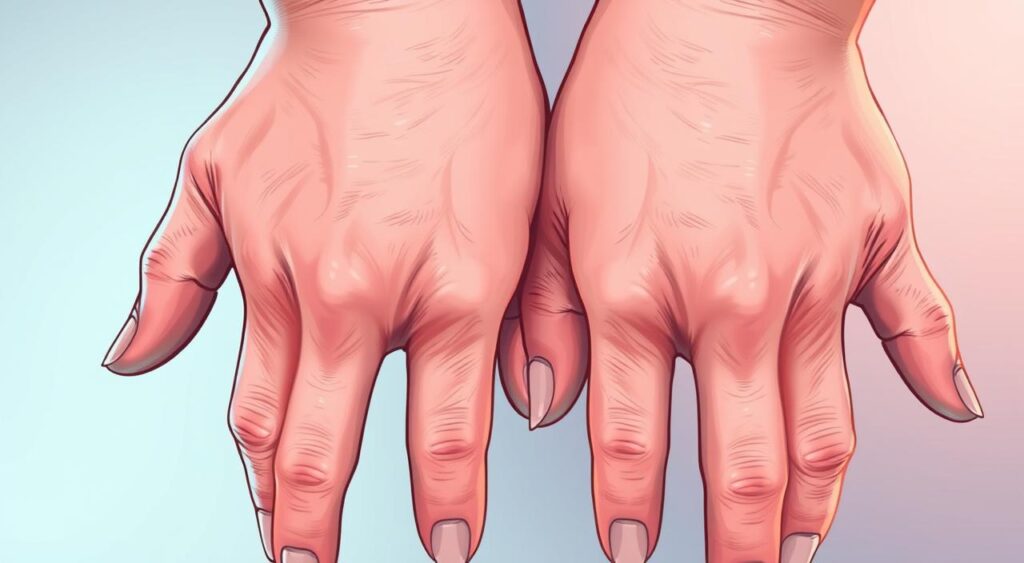Get informed about scleroderma, a chronic autoimmune disease that can affect the skin, connective tissues, and internal organs.
Scleroderma is a chronic autoimmune disease that affects about 300,000 people in the United States. It causes symptoms like skin thickening, inflammation, and scarring. This disease happens when the immune system attacks healthy tissues, making too much collagen.
Scleroderma affects the skin and connective tissues. It’s important to know its symptoms, causes, and treatments to manage it well.

Scleroderma makes skin and connective tissues hard and tight. This can cause skin thickening, joint pain, and digestive problems. Since it’s an autoimmune disease, treating it needs a full plan that fixes the root cause, not just the symptoms.
In this article, we’ll explore scleroderma’s symptoms, causes, and treatments. We’ll focus on systemic sclerosis and autoimmune disease.
Key Takeaways
- Understanding scleroderma and its symptoms is crucial for managing the disease
- Scleroderma is a chronic autoimmune disease that affects the skin and connective tissues
- Systemic sclerosis is another term for scleroderma, which refers to the hardening and tightening of skin and connective tissues
- Scleroderma requires a comprehensive treatment approach that addresses the underlying causes of the condition
- Autoimmune disease plays a significant role in the development and progression of scleroderma
- Early diagnosis and treatment can help alleviate symptoms and improve quality of life for individuals with scleroderma
Understanding Scleroderma: An Overview
Scleroderma is a complex disease that affects the skin and internal organs. It’s important to know the different types to find the right treatment. There are two main types: localized and systemic. Localized affects only the skin, while systemic impacts both the skin and internal organs.
Knowing the risk factors and types of scleroderma is key for diagnosis and treatment. The treatment depends on the type and severity of the disease. Early treatment can greatly improve life quality for those with scleroderma.
What is Scleroderma?
Scleroderma is a chronic disease that causes inflammation and scarring in connective tissue. It can affect the skin, lungs, heart, and kidneys. The exact cause is still unknown, but research points to an autoimmune response.
Types of Scleroderma
There are two main types: localized and systemic. Localized is further divided into morphea and linear scleroderma. Systemic, also known as systemic sclerosis, is divided into limited and diffuse systemic sclerosis.
Who is at Risk?
Anyone can get scleroderma, but it’s more common in women. It can happen at any age, but mostly affects people between 30 and 50. Knowing the risk factors and types is crucial for effective treatment and improving life quality.
Common Signs and Symptoms of Scleroderma
Scleroderma is a chronic autoimmune disease that affects the skin and internal organs. A common symptom is skin thickening, causing tight, hardened skin that may limit movement. Another symptom is Raynaud’s phenomenon, where blood vessels constrict in cold or stress, causing fingers and toes to discolor.
Some common signs and symptoms of scleroderma include:
- Discoloration of the skin, particularly on the hands and feet
- Pain or swelling in the hands and feet
- Thickening of the skin, which can limit movement
- Fatigue and weakness
Recognizing the signs and symptoms of scleroderma, like Raynaud’s phenomenon and skin thickening, is crucial. This helps in seeking medical attention early. Understanding these symptoms can help individuals manage their condition better and improve their quality of life.
Being aware of scleroderma’s common signs and symptoms is the first step towards managing it. It’s important to work with a healthcare provider. They can help create a personalized treatment plan that meets each individual’s needs.
The Impact of Raynaud’s Phenomenon
Raynaud’s phenomenon is a common symptom of scleroderma, an autoimmune disease. It affects the skin and internal organs. In patients with systemic sclerosis, Raynaud’s can lead to serious complications if not managed. It’s important to spot the early signs to prevent these issues and improve life quality.
Early signs of Raynaud’s include discoloration of the fingers and toes, numbness, and tingling. These symptoms can be triggered by cold, stress, or emotional changes. It’s key to manage Raynaud’s symptoms to avoid digital ulcers and gangrene.
Early Warning Signs
- Discoloration of the fingers and toes
- Numbness and tingling
- Pain or burning sensation in the affected areas
Managing Raynaud’s Symptoms
To manage Raynaud’s, patients should avoid cold temperatures, quit smoking, and exercise. Medications like calcium channel blockers and alpha-blockers can also help. They improve blood flow to the affected areas.
Relationship with Scleroderma
Raynaud’s phenomenon is a common symptom of scleroderma. Managing it is key to prevent complications. By recognizing early signs and managing symptoms, patients with systemic sclerosis can improve their life quality and reduce complication risks.
Diagnosing Scleroderma: Medical Tests and Procedures
Diagnosing scleroderma can be tough because its symptoms are similar to other diseases. Doctors use a mix of medical history, physical checks, and lab tests to spot it. Early diagnosis is key to find the best treatment options and handle internal organ involvement.
Some common tests for scleroderma include:
- Skin biopsies
- Imaging tests, such as X-rays and CT scans
- Blood tests to check for autoantibodies
These tests help doctors see how much internal organ involvement there is. They then create a good treatment plan. It’s important to work with a healthcare team to manage scleroderma and avoid problems.

Knowing how scleroderma is diagnosed and the treatment options can help people with it. They can take charge of their condition and better their life quality.
| Medical Test | Purpose |
|---|---|
| Skin biopsy | To examine skin tissue for signs of scleroderma |
| Imaging tests | To evaluate internal organ involvement |
| Blood tests | To check for autoantibodies associated with scleroderma |
Internal Organ Involvement in Systemic Scleroderma
Systemic scleroderma is a connective tissue disorder that can harm many internal organs. It’s a serious form of systemic sclerosis that damages organs and tissues.
Some common internal organ problems in systemic scleroderma include:
- Lung complications, such as pulmonary fibrosis and pulmonary hypertension
- Heart involvement, including cardiac fibrosis and arrhythmias
- Gastrointestinal issues, such as esophageal dysmotility and gastroparesis
Lung Complications
Lung problems are common in systemic scleroderma. They can greatly affect a patient’s life. Pulmonary fibrosis causes lung scarring, leading to breathing issues and other respiratory problems.
Heart Involvement
Heart problems are another serious issue in systemic scleroderma. They raise the risk of heart disease. Cardiac fibrosis causes heart scarring, leading to arrhythmias and other heart issues.
Gastrointestinal Issues
Gastrointestinal problems, like esophageal dysmotility and gastroparesis, can also happen. These issues cause symptoms like trouble swallowing, nausea, and stomach pain.
Treatment Approaches and Medical Interventions
Treatment for scleroderma depends on how severe and widespread the disease is. Pharmacological therapies are used to manage symptoms of this autoimmune disease. The aim is to slow the disease’s progression, reduce inflammation, and prevent complications.
Common treatment options include immunosuppressive medications, physical therapy, and lifestyle changes. These methods help manage symptoms and improve life quality. For instance, physical therapy can enhance mobility and lessen stiffness. Lifestyle changes can also lower the risk of complications.

- Medications to manage pain and inflammation
- Therapies to improve lung function and reduce lung complications risk
- Interventions to manage gastrointestinal issues and prevent malnutrition
It’s crucial to work with a healthcare provider to find the best treatment for scleroderma. By exploring different treatment options, patients can find what works best for them. This helps manage the symptoms of this autoimmune disease.
Living with Scleroderma: Lifestyle Modifications
Managing scleroderma is more than just medical treatment. It also means making big lifestyle changes. These changes can help lessen symptoms like skin thickening and Raynaud’s phenomenon. They can also improve your overall quality of life.
People with scleroderma can benefit from a healthy lifestyle. This includes eating right, exercising regularly, and managing stress well. A diet full of nutrients can help manage symptoms. Regular exercise can improve blood flow and lower the risk of skin thickening.
Dietary Considerations
- Eat a balanced diet rich in fruits, vegetables, and whole grains
- Stay hydrated by drinking plenty of water
- Avoid foods that can trigger Raynaud’s phenomenon, such as caffeine and spicy foods
Exercise and Physical Therapy
Regular exercise can help improve blood flow. This can lessen the severity of Raynaud’s phenomenon and skin thickening. Gentle exercises like yoga or swimming are good. They help improve flexibility and reduce stress.
Stress Management
Stress can make scleroderma symptoms worse. It’s important to find ways to manage stress. This can include meditation, deep breathing exercises, or hobbies that bring joy.
By making these lifestyle changes a part of your daily life, you can manage your symptoms better. It’s key to work closely with your healthcare provider. They can help create a plan that meets your specific needs and concerns.
Support Systems and Resources
Living with a connective tissue disorder like scleroderma is tough. Having the right support and resources is key. Scleroderma can affect internal organs, making life harder. But, there are many resources to help with emotional support and practical tips.
Some of the support systems and resources available include:
- Support groups, where patients can connect with others who are living with scleroderma
- Online resources, such as websites and forums, that provide information and advice on managing the condition
- Advocacy organizations, which work to raise awareness and promote research into scleroderma
These resources help patients deal with the physical and emotional challenges of scleroderma. By connecting with others, patients feel less alone. They gain strength to manage their condition better.
It’s important for patients to use these support systems and resources. Doing so can improve their well-being and quality of life. They can better handle the challenges of scleroderma and find the support they need to thrive.
Conclusion: Managing Your Journey with Scleroderma
Dealing with scleroderma, an autoimmune disease, needs a full plan. This includes medical care, lifestyle changes, and emotional support. Remember, you’re not alone in this fight.
Scleroderma brings many challenges, but there are many ways to handle it. With your doctor’s help, you can make a plan that fits you. This plan can help you live well despite the disease.
Self-care and making lifestyle changes are key. Gentle exercises, a healthy diet, and stress management are important. Also, joining support groups and learning more about scleroderma can help a lot.
There’s hope for better treatments and a brighter future for scleroderma patients. Stay informed, speak up for yourself, and keep up with your care. This way, you can manage your scleroderma journey well.
FAQ
Q: What is scleroderma?
A: Scleroderma is a chronic autoimmune disease. It affects the skin and connective tissues. The skin becomes thick and hard, causing various symptoms.
Q: What are the different types of scleroderma?
A: There are two main types. Localized scleroderma only affects the skin. Systemic scleroderma affects both the skin and internal organs.
Q: Who is at risk of developing scleroderma?
A: Scleroderma can happen to anyone, but it’s more common in middle-aged adults. Women are more likely to get it than men.
Q: What are the common signs and symptoms of scleroderma?
A: Common symptoms include skin thickening, inflammation, and scarring. Raynaud’s phenomenon is also common. It causes blood vessels to constrict in cold or stress.
Q: What is the impact of Raynaud’s phenomenon on scleroderma patients?
A: Raynaud’s phenomenon is a common symptom. Managing it is key to preventing complications. Early signs and effective management are crucial for patients.
Q: How is scleroderma diagnosed?
A: Diagnosis involves medical history, physical exam, and lab tests. Skin biopsies and imaging tests are used. Early diagnosis and treatment are vital.
Q: How can internal organ involvement in systemic scleroderma be managed?
A: Systemic scleroderma can affect organs like the lungs, heart, and gut. Managing these complications is key to preventing damage and improving health.
Q: What treatment approaches are available for scleroderma?
A: Treatment varies based on disease severity. It may include medications, physical therapy, and lifestyle changes. The goal is to manage symptoms and improve quality of life.
Q: What lifestyle modifications can help manage scleroderma?
A: Making lifestyle changes can help manage symptoms. This includes dietary changes, exercise, and stress management. These can improve quality of life.
Q: What support systems and resources are available for scleroderma patients?
A: Support systems and resources are vital for patients. They include support groups, online resources, and advocacy organizations. These provide emotional support and practical advice.
